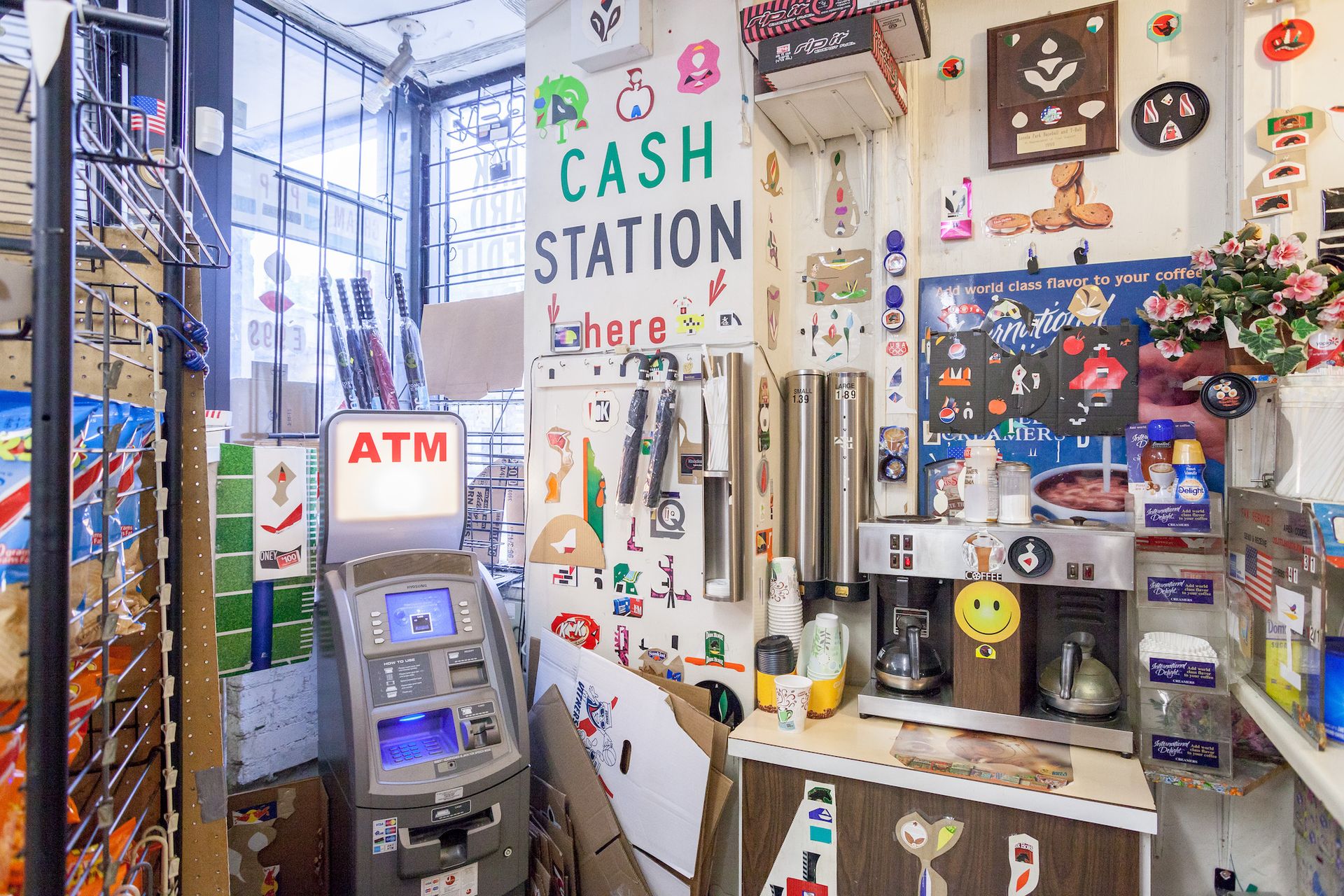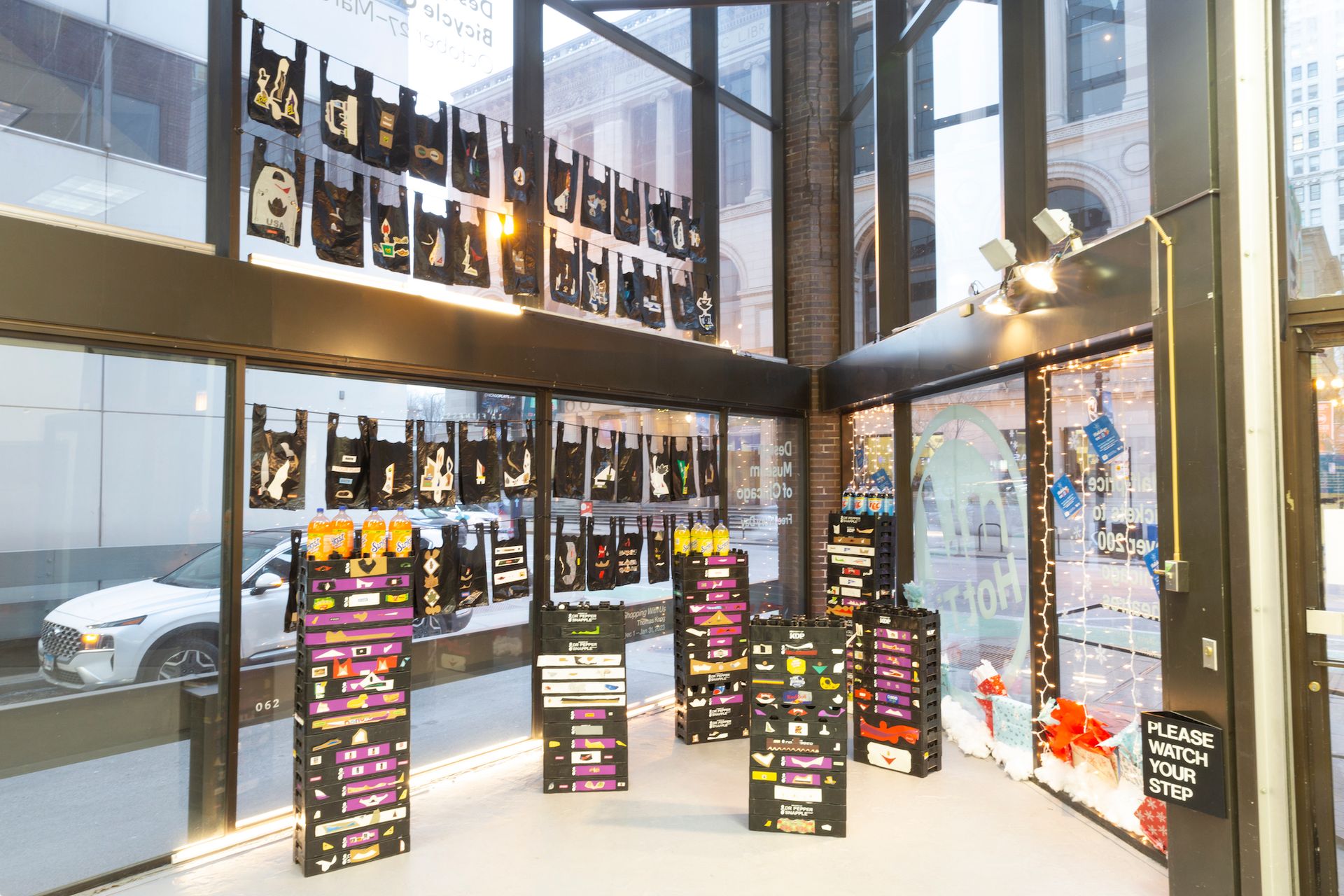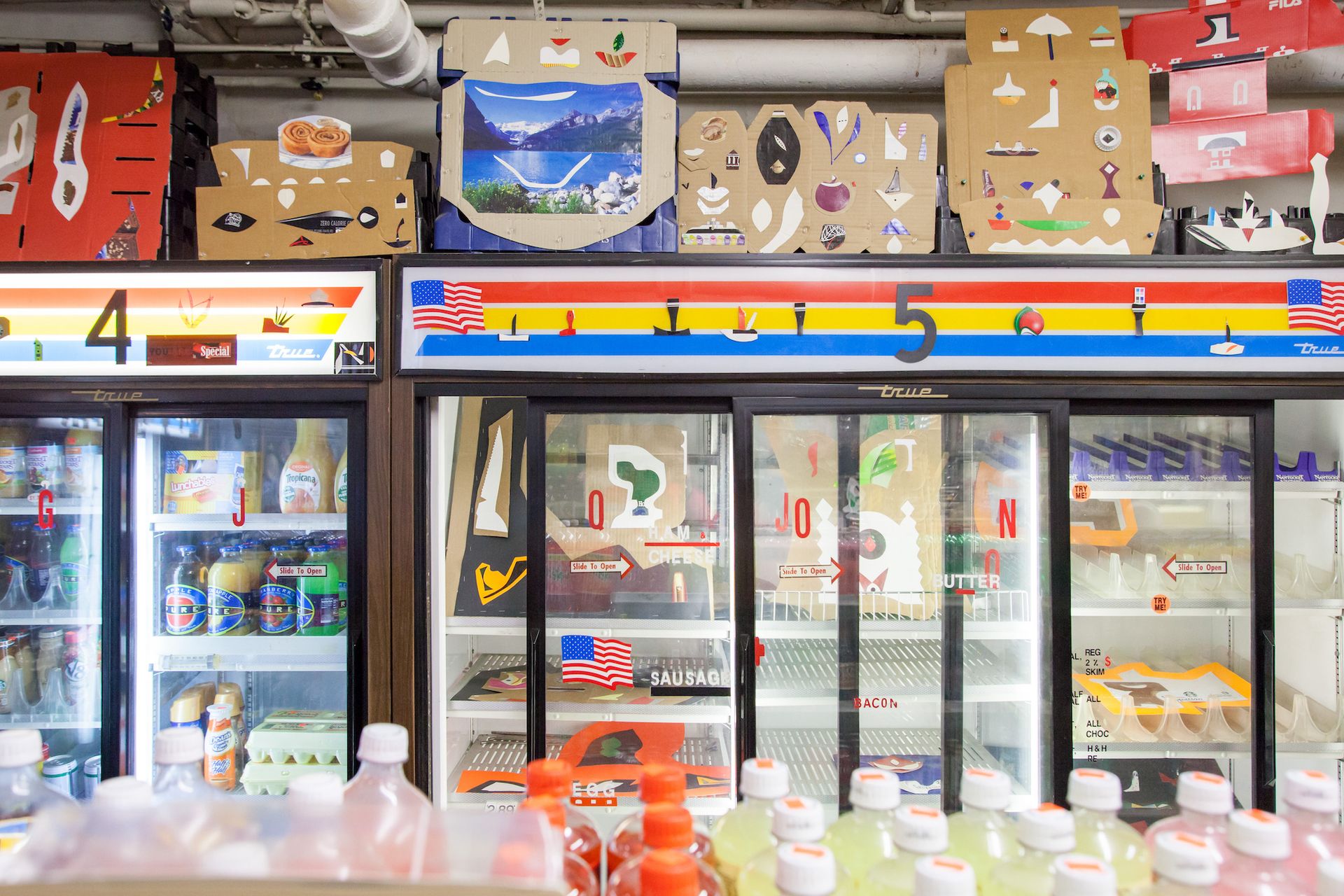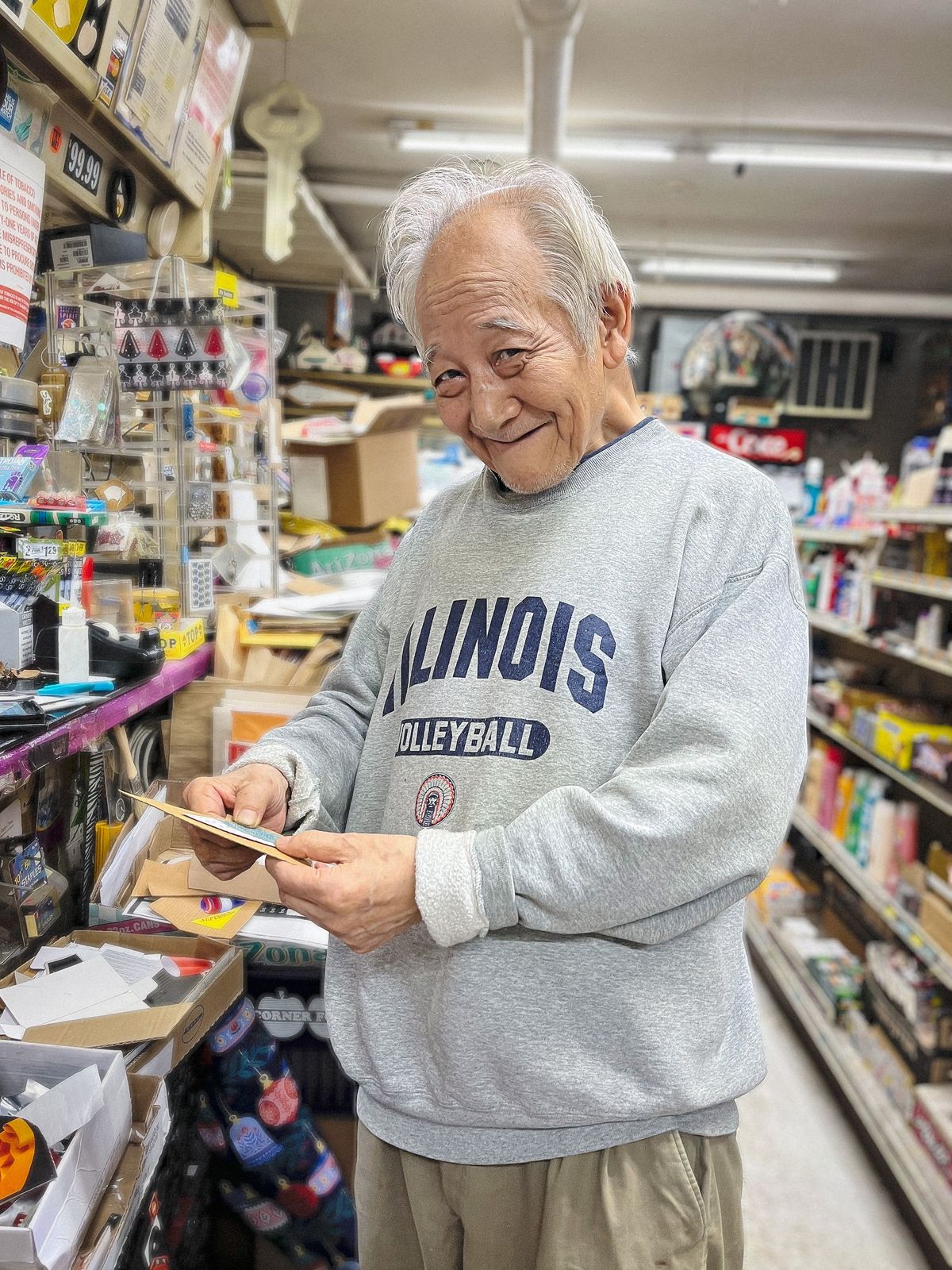Thomas Kong, an artist who made whimsical, joyous collages cannily composed of food packaging, plastic bags and other material scraps, often sourced from the convenience store he operated in Chicago for 17 years, died on 1 May. He was 73.
The cause was complications of pneumonia, according to curator SY Lim, who has worked closely with Kong in recent years. Kong was diagnosed with leukaemia a few weeks ago and was undergoing chemotherapy.
For close to a decade Kong quietly made art behind his shop counter in the neighbourhood of Rogers Park, cutting up objects including cigarette packs and snack boxes and glueing them onto cardboard or styrofoam containers. He often added a slip of paper printed with the words “Be happy”. The store, Kim’s Corner Food, became a kind of gallery, too, as Kong’s creations gradually covered every inch of the room, lining the shelves and dotting fridge doors and the coffee station. An ATM stands by a wall papered with a beguiling hodgepodge: a creatively pruned Kit Kat wrapper, pristinely layered packaging with excised provenance, cut-out letters that spell “Cash station here”.

The interior of Kim's Corner Food in Chicago, featuring works by Thomas Kong Dan Miller
Kong’s collages quickly got the attention of other local artists, including a neighbour, Dan Miller, who in 2015 worked with Kong to open a community art space in the shop’s storage room. The Back Room hosted exhibitions by other artists whose practices intersected with Kong’s own, and it housed Kong’s fast-growing archive, which visitors could peruse. By the time the Back Room closed in March 2019, Kong and his store had become fixtures in Chicago’s rich community of artist-run spaces.
“His art had an element of surprise and humour, which are very much a part of the Chicago vibe in the art scene,” Allison Peters Quinn, director of the Hyde Park Art Center, says. “Artists would hear about the store from other artists and make the pilgrimage to Rogers Park to see his installations. I think artists really respected how he incorporated his work life and creative life—his art was made alongside stocking aisles.”
Kong also increasingly exhibited his work in galleries in his later years, although he never received a major institutional solo exhibition in his lifetime. In 2020, his collages were featured in Artists Run Chicago 2.0, a major exhibition at the Hyde Park Art Center that celebrated Chicago’s independent art scene. In December 2022, the Design Museum of Chicago hosted a solo exhibition of his work in a pop-up exhibition space.

Works by Thomas Kong on view in a pop-up exhibition organised by the Chicago Design Museum SY Lim
Lim, the executive director of Chicago’s 062 gallery, is responsible for much of this effort to bring Kong’s works to a greater public. After meeting in 2017, the two developed a strong friendship, in part because of their shared Korean heritage (“I asked him if I should call him grandpa in Korean,” Lim says. “He said, ‘Absolutely not. I don’t want to be called grandpa. I want to be your friend.’”). Lim encouraged Kong to exhibit more widely, including at 062, and began finding more platforms to sell his art.
“I really just thought that people should see his work and what he was actually doing, especially being a minority,” Lim says. “He was really special. The way he sees all these objects—anything in the store, anything he could find on the street, was basically materials. The whole world was filled with art materials.”
Born Tae Kwon Kong on 16 January 1950, in what was then Hwanghae Province in North Korea, Kong came to art in his 60s. His parents were landowning farmers when North Korean communists kidnapped and murdered his father, he told Borderless Magazine in 2021. When he was six months old, he and his mother and five sisters escaped on a rowboat to Deokjeokdo island in Incheon, South Korea. Kong went to Sogang University in Seoul to study English literature and after graduating worked for a Korean airline, which gave him the opportunity to travel to places including Singapore, Taiwan and Bangkok.
It was Chicago where Kong made his lasting home, in 1977, after he married Sandy Kong, who survives him. His youngest sister had moved there three years prior to pursue a career in nursing and asked him to join her on a family visa. “The economy in Korea was very bad at the time, and America was very dream-worthy to me,” he told Borderless Magazine. Kong recalled facing language barriers, but he quickly picked up work at a gas station. He spent the following decades operating businesses often run by other immigrants of his generation who settled in the United States: shoe-repair shops in Hammond, Indiana, then Skokie, Illinois, then liquor shops, followed by a dry-cleaning business. In 2006, he returned to Chicago and took over a shop run by a Korean man named Kim.
As Kong remembered it, he began collaging around 2014, almost on a whim. He was cleaning the shop’s shelves and had an idea to embellish them. He cut up packages and covered the surfaces with the paper before arranging the merchandise on top. “I thought it was decoration, interior design. It looked good,” he told Borderless Magazine. “Then I had an idea to cut different paper shapes and use different colours, and I started putting them on the windows, the walls, outdoors, and the store looked a little better. The customers said it looked nice. They said it was beautiful, kind of unusual.”
Kong kept making collages while manning the cash register, from 8am to 8pm daily, continuing nearly up to the end. Cutting and arranging materials was a way to pass time, but it also filled him with a sense of completion, he said. He even spent many hours at Kim’s during the height of the pandemic, filling the room with new work. Lim, who was supporting him by bringing him groceries and ordering him food, estimates that the amount of work in the shop doubled during this period because the proprietor was so prolific.

Works by Thomas Kong inside Kim’s Corner Food Dan Miller
Now, Chicago’s artist community, which counts Kong as one of its own, faces the challenge of how to preserve his work, which is entwined with his profession and workplace. “How do we not lose Thomas’s story? How do we not lose the authenticity of what he was able to create?” Peters Quinn says. “I hope that people support efforts to preserve history like this that goes on quietly in the every day—that if we didn’t have, our lives would be so much more uninteresting.”
To start, Lim and Kong’s son, Marshall Kong, have organised a GoFundMe campaign to help cover the costs of running Kim’s Corner Food until the end of June so it remains accessible to the public. Lim has also enlisted the photographer Guanyu Xu to document the shop and the architectural designer Andrea Hunt to 3D scan its interior. Lim hopes to eventually publish a book on Kong’s life and work and find an institution that will care for his archives. She also wants to fulfil Kong’s wish of exhibiting his work in his home country of South Korea.
For many artists who passed through Kim’s Corner Food, Kong’s legacy lies in something aspirational: the constancy of his pursuits and his ability to seemingly always enjoy creating. Max Guy, who exhibited in the Back Room in 2016, describes Kong as “the Giving Tree”—an artist who inspired other artists to be “as resourceful and as prolific and as free as I saw him.
“Even in Chicago, where it’s very easy to make work, people are still burdened by so much when they make it,” Guy says. “He was a reminder of how you could make work without burden and still espouse all the values of a Chicago artist. At its best—and it was very often at its best—it was an unburdened studio practice.”
Kong may not initially have considered his collages art, but he “fully embraced being an artist” in his final years, Lim says. “A lot of our friends were inspired by him and his work ethic—a Korean guy who was very humble, making work every day … and always smoking so much in the store. He was an artist of artists.”


